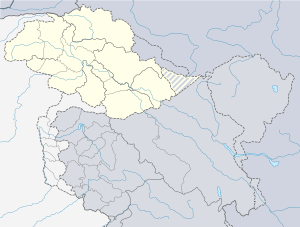Skardu Fort
Skardu Fort or Kharpocho (Balti: کھر فچو; Urdu: قلعہ سکردو) means The king of Forts is a fort in Skardu city in Gilgit-Baltistan region of Pakistan. Australian mountaineer and film maker Greg Child writes that the fort is "perched above the junction of the rivers" and overlooks the Rock of Skardu.[1]
| Skardu Fort قلعہ سکردو | |
|---|---|
 A view of fort from the foot of Mont Kharpocho | |
| Location | Skardu, Gilgit-Baltistan |
| Built | 16th Century CE |
 Location of Skardu Fort قلعہ سکردو in Gilgit Baltistan  Skardu Fort (Pakistan) | |
_p232_ISKARDO_FORT.jpg)
History
The fort was built by the king Ali Sher Khan Anchan in the end of the sixteenth century.[2] General Zorawar Singh of the Dogra Rajput clan working under Maharaja Gulab Singh realized the importance of the fort's location in the town and so he occupied the fort. It was part of his many military campaigns to annex the areas of Baltistan to the princely state of Jammu and Kashmir.[3] The fort was razed to the ground in 1857 under the guidance of Ranbir Singh.[4] Mughal emperor Aurangzeb also tried to occupy the fort, which went in vain.[5]
First Kashmir War
During the First Kashmir War on 1947, Jammu and Kashmir State Forces were deployed inside the fort under the command of Lt. Col. Sher Jung Thapa.[6] The Gilgit Scouts and rebel troops of the State Forces, under the command of Pakistan Army, laid siege to the fort.[7] On 11 February 1948, the Pakistani forces battled with the Skardu garrison of the fort. After a six-hour-long battle between the two, the attackers retreated. They came again on 14 February directing "harassing fire into the fort".[8] The siege lasted more than six months. Finally, having exhausted ammunition and rations, the Kashmir forces left the fort in small batches on 13 August 1948. The fort succumbed on the 14 August. All the remaining men were reportedly killed by the invaders, except for Col. Thapa and his Sikh orderly, who were taken prisoner.[6][8] Skardu became part of the Pakistan-controlled Kashmir, eventually renamed Gilgit-Baltistan.
Inside Pakistan
American mountaineers Robert Bates and Charles Houston write that they were "lavishly entertained" as they visited the fort.[9]
See also
| Wikimedia Commons has media related to Skardu Fort. |
Gallery
References
- Greg Child. Thin Air: Encounters in the Himalayas. The Mountaineers Books. p. 72. ISBN 9780898865882.
- Shiri Ram Bakshi. Kashmir: Valley and Its Culture. Sarup & Sons. p. 124. ISBN 9788185431970.
- Shankar Prasad. The Gallant Dogras: An Illustrated History of the Dogra Regiment. Lancer Publishers. p. 18. ISBN 9788170622680.
- GD Bakshi. Footprints in the Snow: On the Trail of Zorawar Singh. Lancer Publishers. p. 155. ISBN 9788170622925.
- Narendra S. Bisht. Encyclopaedic Ethnography of the Himalayan Tribes: A-D. Global Vision Pub House. p. 104. ISBN 9788187746928.
- J Francis. Short Stories from the History of the Indian Army Since August 1947. Vij Books India Pvt Ltd. pp. 26–27. ISBN 9789382652175.
- Jagjit Singh Arora. With Honour & Glory: Wars fought by India 1947–1999. Lancer Publishers. p. 13. ISBN 9788170621096.
- B. Chakravorty. Stories of Heroism: PVC & MVC Winners. Allied Publishers. pp. 352–353. ISBN 9788170235163.
- Robert Bares, Charles Houston. K2, The Savage Mountain: The Classic True Story Of Disaster And Survival On The World's Second-Highest Mountain. Rowman & Littlefield. p. 30. ISBN 9781461745792.

_p010_ISKARDO.jpg)

